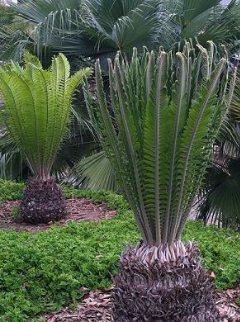In the warmer spring months following a fairly cold January and February, we are happy to see many of our cycads in the ground and in containers begin to push new leaves. This winter we had some very cold temperatures, resulting in many frosty mornings, and even a couple hail storms.
 As you might expect, we had a lot of cold damage in the garden. And as a result, March and April of this year, much of my time in the garden was spent removing frost bitten, brown cycad leaves. The damage this year was reminiscent of the damage from “The Winter that Rocked My World”, the blog from December of 2012.
As you might expect, we had a lot of cold damage in the garden. And as a result, March and April of this year, much of my time in the garden was spent removing frost bitten, brown cycad leaves. The damage this year was reminiscent of the damage from “The Winter that Rocked My World”, the blog from December of 2012.
But now that leaves have been cut back, it is easy to see how spring rains, sunshine and longer days have done their magic once again, and these hearty plants are pushing new leaf flushes. This is when it is time to give nature a helping hand and pump this growth with fertilizer.
I have made an effort to grow my cycads using as little chemical fertilizer as possible. I really like the idea of growing nearly all of my plants with organic nutrition. The one time of the year that I break with tradition is when I have plants pushing new leaves. I like the fact that the occasional seasonal shot of a water soluble plant food gives the plant immediate access to absorb useful nutrients.

I know that it can be argued that chemical fertilizer can do more harm than good, but I do use it sparingly and primarily during the time of leaf production. The repeated use of chemical fertilizer can deplete and damage many of the beneficial organisms in a healthy soil, but I don’t think that the occasional use will have a devastating effect on the soil.
After leaves have hardened off, my fertilizer applications include mostly organic components. This helps to feed, repair, and replace colonies of micro-organisms in the soil that may have sustained damage from chemical fertilizer applications.
As you can see, I have taken a middle of the road approach to the application of fertilizer. The debate of “chemical or organic” is likely to persist, but in time, each grower will usually settle on what works for him/her. This feeding process has proven successful for me.
Grow and prosper,
Keith